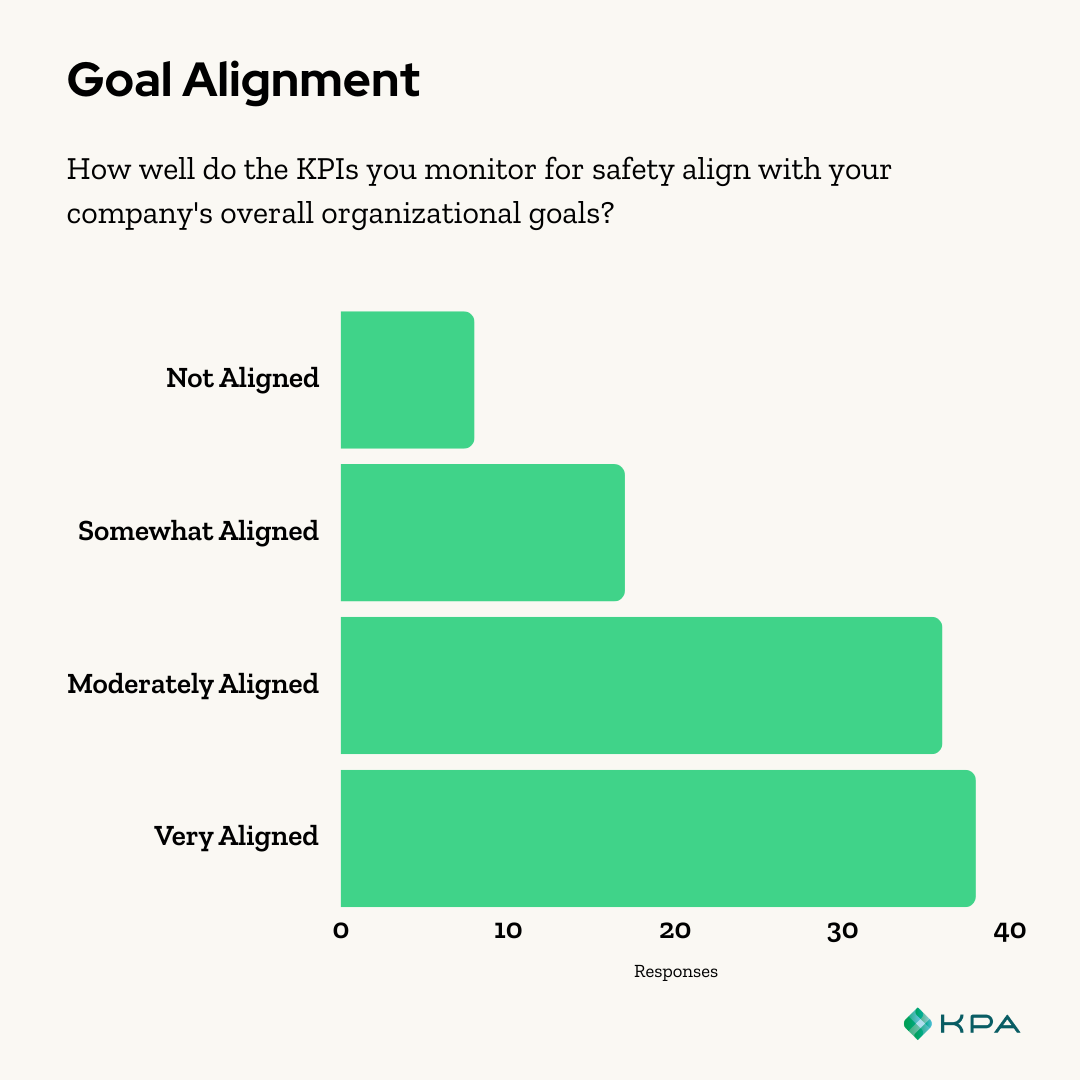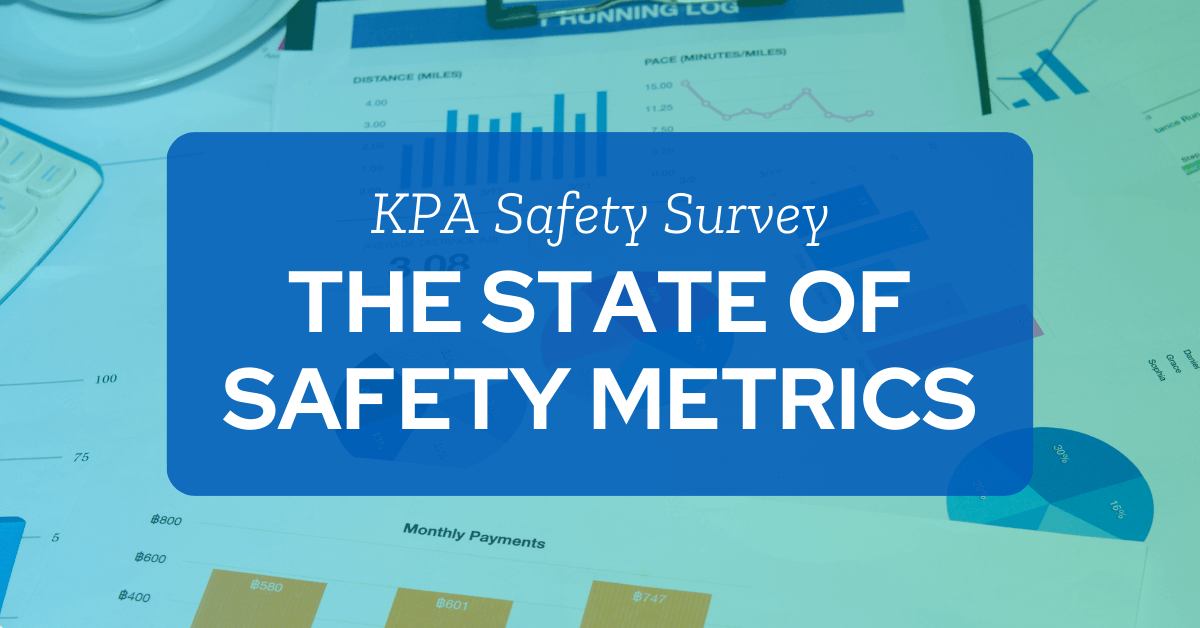In the realm of workplace safety, aligning safety metrics with overall organizational goals is not just a best practice—it’s a critical factor in fostering a robust safety culture. A recent KPA survey reveals that while many organizations report moderate to strong alignment between their safety KPIs and company objectives, many still struggle with this crucial connection.
This gap highlights an important opportunity for safety managers to reassess and refine their KPIs, ensuring they’re not just measuring activity but driving meaningful improvements that contribute to both safety outcomes and organizational success.
Aligning KPIs with Organizational Goals
About the Survey
In partnership with EHS Daily Advisor, our recent survey gathered valuable data from 110 industry leaders, safety officers, and employees, shedding light on the most effective KPIs and their impact on workplace safety.
Encouragingly, 75% of survey respondents reported that their safety KPIs are either moderately or very aligned with their company’s overall organizational goals. This alignment is crucial for fostering a culture of safety that permeates all levels of the organization.
However, there’s still room for improvement:
- 25% of respondents indicated that their safety KPIs are only somewhat aligned or not aligned at all with company goals
This gap presents an opportunity for organizations to reassess their KPIs and ensure they’re measuring what truly matters for safety outcomes.

KPA’s recent survey of safety professionals reveals interesting insights into how organizations approach safety metrics and where there’s room for growth.
The Takeaway
For safety managers looking to improve the alignment of their KPIs with organizational goals and enhance their effectiveness, consider the following steps:
- Conduct a comprehensive review of your current KPIs in collaboration with leadership from various departments. This cross-functional approach ensures that safety goals are integrated with broader business objectives.
- Develop a clear understanding of your organization’s strategic goals and how safety contributes to these objectives. This might involve discussions with senior management to understand how they view the role of safety in the company’s success.
- Create a “KPI alignment matrix” that maps each safety KPI to specific organizational goals. This visual tool can help identify gaps or redundancies in your current KPI set.
- Regularly solicit feedback from front-line workers, supervisors, and management on the relevance and effectiveness of your KPIs. Their insights can help ensure you’re measuring what truly matters for safety in your work environment.
- Build a system for periodic KPI review and adjustment. As your organization evolves, so should your safety metrics. Set a schedule (e.g., quarterly or bi-annually) to reassess and refine your KPIs.
- Consider adopting a balanced scorecard approach that includes both leading and lagging indicators. This can provide a more comprehensive view of safety performance and its alignment with organizational goals.
- Use technology to make KPI data more accessible and actionable across the organization. An integrated EHS software solution can help democratize safety data, making it easier for all levels of the organization to understand and act on safety performance metrics.
Remember, the goal is not just alignment for alignment’s sake but to create a set of KPIs that drive meaningful improvements in safety while contributing to your organization’s overall success. By taking these steps, you can create a more robust, aligned, and effective set of safety KPIs that truly reflect what matters for ensuring safety in your unique organizational context.
Here’s What KPA Customers Say
Over in the KPA Connect customer community, we asked our customers for their take on aligning their safety metrics with company goals. Here’s what they had to say.
“Don’t choose a metric that can be targeted without improving execution or safety.”
– Perry Rodriguez, Quality Manager, Butch’s Casing
Continuous Alignment: The Key to Safety and Business Excellence
Aligning safety KPIs with organizational goals is not a one-time task but an ongoing process that requires commitment, collaboration, and continuous refinement. By implementing the steps outlined above, safety managers can create a more robust, relevant, and effective set of metrics that truly drive safety improvements while supporting broader business objectives.
When properly aligned, the right KPIs do more than just measure—they motivate, guide, and transform. Take the time to align your safety KPIs with your organization’s goals, and watch as your safety culture flourishes, contributing to both employee well-being and overall business success.
Monitoring Safety Program Metrics is easier with solid EHS software in your team’s hands.
KPA simplifies data visualization and reporting, giving users easy access to actionable insights into their EHS program performance. Your data is presented in real-time, so no delay or extra steps are required to access the information. The dashboards are configured based on features tailored to your business’s unique requirements, giving you the power to make informed decisions that impact workplace safety.
Let KPA show you how to take a data-driven approach to safety.
Related Content
Explore more comprehensive articles, specialized guides, and insightful interviews selected, offering fresh insights, data-driven analysis, and expert perspectives.
KPA’s recent survey of safety professionals reveals interesting insights into how organizations approach safety metrics and where there’s room for growth.

